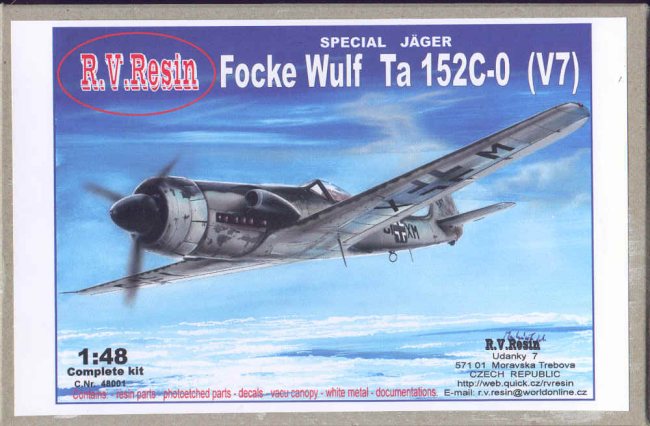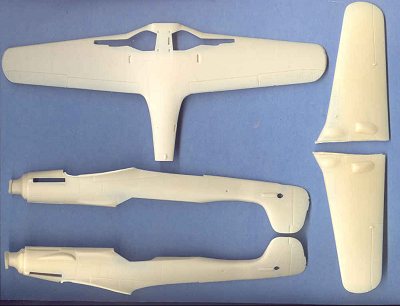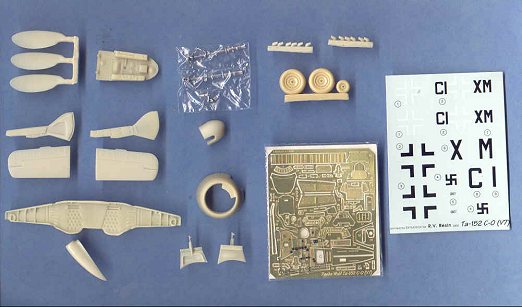
|
KIT: |
R.V. Resins |
|
KIT # |
? |
|
PRICE: |
$32.00 |
|
DECALS: |
one aircraft |
|
REVIEW & |
|
|
NOTES: |
Resin with metal, etched brass and vac canopy |

|
HISTORY |
The Ta-152C was the airplane Kurt Tank was thinking of when he told the pilots of III/JG54 that the Fw-190D-9 they had just converted onto was "an interim type."
The Focke-Wulf Fw-190 had been plagued from the outset with a lack of high altitude performance, a situation that led to the continued development of the Bf-109 series past its development peak, due to the fact it had outstanding high altitude performance, which became more and more necessary as the Eighth Air Force increased in size and effectiveness with its high altitude daylight assault on Germany.
The Dora-9, powered by the Junkers Jumo 213A - a bomber engine - went some distance in solving the problem of high altitude performance, but the airplane still lost power above 25,000 feet, which was just the altitude the B-17s and B-24s came in at. Tank argued continually with the Reichsluftfahrtministerium (RLM) to be allowed to put a Daimler-Benz DB603 series engine in the Jumo-powered airframe, convinced that such a powerplant would provide the high altitude performance so needed. Tank's success with the high-altitude Ta-152H - the first of the series that carried its designer's name in its designation - which was powered by the Jumo 213E, demonstrated that he was on the right track.
Finally, in August 1944, following the failure of the Ta-152B program permission was granted to adapt the Ta-152B airframe to the DB603 series engine. Tank made a maximum effort to bring the new type forward, utilizing as much of the B-series airframe as possible. Plans were afoot to commence production deliveries from the Roland Group by April 1945.
Two Fw-190D prototypes were modified with DB603L engines as the Fw-190V20/U1 and Fw-190V21/U1; unfortunately, the V20 was destroyed in an air raid on August 5, 1944. The V21 first flew on November 3, 1944, powered by a DB603E. In the meantime, three Ta-152C development aircraft, the V6, V7 and V8, were under construction, with plans to power them with the DB603L.
The Ta-152 V6, powered by a DB603LA engine, was otherwise similar to the Fw-190V21, and made its first flight on December 17, 1944, flown by Hans Sander. The Ta-152 V7 was similar, with the addition of the R-11 all-weather kit, thus representing what would be the Ta-152C-0/R11. This aircraft first flew January 27, 1945, again at the hands of Hans Sander. The Ta-152 V8, with incorporated the new Revi EZ-42 gyro cunsight, was the development prototype of the Ta-152C-1, and flew on January 14, 1945. All three had the heavy armament of a 30mm MK108 Motorkannon, two 20mm MG151s in the upper fuselage ahead of the cockpit, and two 20mm MG151s in the wing roots.
The V6 and V8 were powered by the DB603L, while the V7 was powered by the DB603EM, which offered 1,800 h.p. at takeoff, boosted to 2,250 h.p. with MW50, an improvement of 150 h.p. in both categories over the DB603L. The V7 was the fastest of the three prototypes with a sea level maximum speed of 342 mph and 370 mph without and with MW50, though at higher altitudes the DB603L provided substantially better performance. Unfortunately, both the DB603EM and the DB603L required 96 octane C3 fuel, which was becoming harder to get hold of in 1945 Germany; as a result, it was decided that the production aircraft would be powered by the DB603LA, since this engine could use both 87 octane B4 or the higher-octane C3.
The production versions would have been the Ta-152C-1 and Ta-152C-3, with the latter substituting a 30mm MK103 for the MK108, with all equipped with the R11 all-weather equipment fit.
By the spring of 1945, however, Western and Soviet forces were sweeping into Germany, and there was no more time left for development. The factories where the Ta-152C was to be produced were still at the component production stage when their assembly lines were overrun.
There can be little doubt that, had the war lasted into 1946, that the Ta-152C would have proven a worthy opponent to the Spitfire 22/24 and the P-51H, which were its closest Allied contemporaries.
|
THE KIT |
 |
 |
The only previous kit of the Ta-152C available in 1/48 was the last release by Trimaster, which had resin conversion parts for the engine cowling and wings for its Ta-152H kit. While a Ta-152C could be built, the kit itself suffered from lack of molding quality and fit for the resin parts.
This new kit, a limited-run all-resin version designed by Radek Vavrina from the Czech Republic and marketed by R.V. Resins, effectively makes the old Trimaster kit obsolete, assuming one could find it at less than stratospheric kit collector prices.
Upon opening the box, I was struck by the thickness of the resin molds of the main parts, and was worried about fit. This is not a problem. Once the joints have been cleaned up, the model will be able to be assembled using only Mr. Surfacer 500 for the seams.
One outstanding aspect of this kit is the surface detail. It is perfectly obvious that the roots of this model lie in the Trimaster Ta-152H, and that's not a bad thing, as that kit is still state-of-the-art in surface detail and fit. This resin kit, however, goes even further with very petite and to-scale representations of the flush-riveted skin overall. You can't see this in the scans here, and you have a hard time seeing it on the bare resin parts without holding them to the light to see shadows, but once there is a coat of paint on this model, this surface is going to pop out and be just stunning.
The small parts are beautifully molded, with sharp trailing edges on the horizontal stabilizer and prop blades. The cockpit is multi-media, with resin, photo-etch, and a very clear vacuform blown canopy - there is only one canopy, so the vac-challenged will have to be careful here.
The decals are for the Ta-152C-0 (V7) prototype.
Overall:
This kit is a wonderful addition to anyone's Focke-Wulf Air Force, and is a definite gotta-have for members of the Wurger Fanatics Club (of which yours truly is the most-recent recruit).
Availability:
Eagle Editions will be the exclusive North American distributor of R.V. Resins kits. I am informed they should have kits for delivery by May 1, and are taking pre-orders now for the limited number of kits that will be available. Contact them at: http://www.eagle-editions.com to order yours.
If you would like your product reviewed fairly and quickly by a site that averages over 2,200 visits a day, please contact me or see other details in the Note to Contributors.